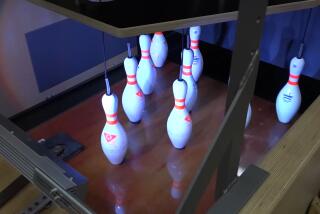New kicks from croquet
- Share via
“The game of golf would lose a great deal if croquet mallets and billiard cues were allowed on the putting green,” Hemingway once wrote. The game of croquet, however, might have gained an edge with the addition of soccer equipment and PVC pipe.
If you’re a fan of social sports, take a whack at Toequet, which was recently developed at the National Croquet Center in West Palm Beach, Fla. The basic rules of croquet -- either six- or nine-wicket -- apply, but instead of using a mallet, players kick colored soccer balls around the course.
The game’s inventor, Dennis Ridgway of Terre Haute, Ind., was looking for a way to play a decent round of croquet on uneven terrain and on lawns with tall grass, and started kicking around a new idea in 1998.
Development required a bit of trial and error. “Originally, we played with basketballs,” Ridgway, 68, a retired Columbia House executive, said, “but with soccer balls we could get colors closer to croquet balls. And people are more comfortable kicking those.”
The equipment is sold by the Toequet Co. (www.toequet.com), which Ridgway and several business partners founded last year, as well as the Pro Shop at the National Croquet Center (www.croquetproshop.com/homepage.html). Sets, which include solid-colored soccer balls (blue, green, red and yellow) and wickets, cost about $150.
You can make the game as challenging as you want. For “extreme” Toequet, try arranging the oversized PVC wickets around trees or other obstacles. For a good workout, play the aerobic version, in which the next player takes a turn before the last ball has stopped rolling.
And for those who don’t like kicking, use regulation 3-pound mallets to propel the soccer balls for a super-sized version of the game known as Malletball.
Ana Cantu
*
What that ‘meow’ means
HAVE you ever wanted to really chat with your cat? Do you wonder whether your furry friend prefers catnip to kibble? Are you desperate for the answer to “Why do you use the couch instead of your scratching post?”
To help you in these hairy situations, the Meowlingual, a device developed by Takara Toys, can allegedly translate your pet’s purrs, hisses and yowls into words. Like the company’s popular Bowlingual, a dog translator, the cat-shaped gadget relies on voiceprint technology. Takara commissioned acoustics researchers to collect thousands of sound samples, which animal behaviorists then grouped by emotion.
To open up channels of communication, hold the palm-sized Meowlingual to your cat’s mouth. A microphone picks up the sound, which is matched to one of about 200 phrases. The translation pops onto the LCD screen.
In case your finicky feline turns tail without so much as a meow, the pink plastic console includes other features, such as a data analysis function, which tracks your cat’s emotional changes. A medical reference guide gives users information on feline health problems. And while you’re waiting for hiss and tell, the gadget will generate a daily horoscope.
The Meowlingual is slated to go on sale later this month in Japan. An English version is expected to reach the United States in 2004. The cost? About $80.
-- Ana Cantu
More to Read
Sign up for The Wild
We’ll help you find the best places to hike, bike and run, as well as the perfect silent spots for meditation and yoga.
You may occasionally receive promotional content from the Los Angeles Times.






